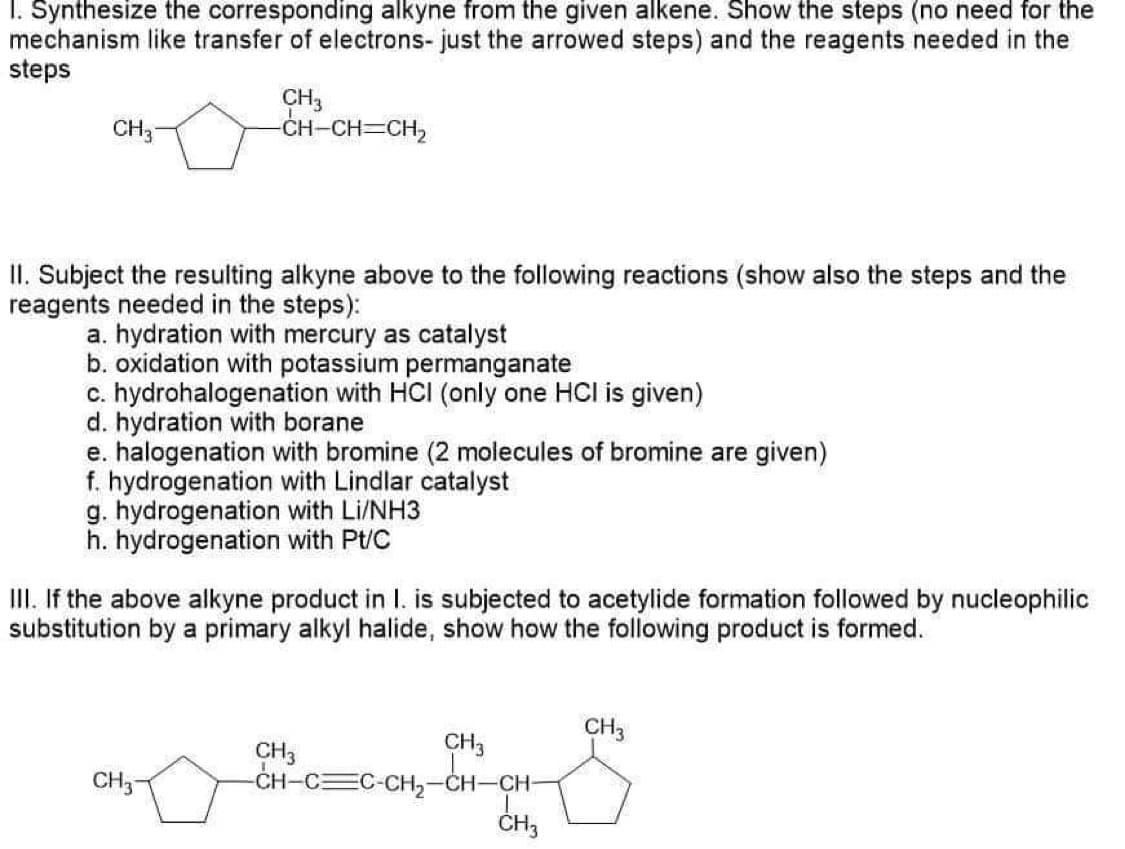I. Synthesize the corresponding alkyne from the given alkene. Show the steps (no need for the mechanism like transfer of electrons- just the arrowed steps) and the reagents needed in the steps CH3 -CH-CH=CH, CH;
I. Synthesize the corresponding alkyne from the given alkene. Show the steps (no need for the mechanism like transfer of electrons- just the arrowed steps) and the reagents needed in the steps CH3 -CH-CH=CH, CH;
Chemistry
10th Edition
ISBN:9781305957404
Author:Steven S. Zumdahl, Susan A. Zumdahl, Donald J. DeCoste
Publisher:Steven S. Zumdahl, Susan A. Zumdahl, Donald J. DeCoste
Chapter1: Chemical Foundations
Section: Chapter Questions
Problem 1RQ: Define and explain the differences between the following terms. a. law and theory b. theory and...
Related questions
Question
I. Handwritten

Transcribed Image Text:1. Synthesize the corresponding alkyne from the given alkene. Show the steps (no need for the
mechanism like transfer of electrons- just the arrowed steps) and the reagents needed in the
steps
CH3
-CH-CH=CH₂
CH3
II. Subject the resulting alkyne above to the following reactions (show also the steps and the
reagents needed in the steps):
a. hydration with mercury as catalyst
b. oxidation with potassium permanganate
c. hydrohalogenation with HCI (only one HCI is given)
d. hydration with borane
e. halogenation with bromine (2 molecules of bromine are given)
f. hydrogenation with Lindlar catalyst
g. hydrogenation with Li/NH3
h. hydrogenation with Pt/C
III. If the above alkyne product in I. is subjected to acetylide formation followed by nucleophilic
substitution by a primary alkyl halide, show how the following product is formed.
CH3
CH3
CH3
-CH-C
CH3-
C-CH₂-CH-CH-
CH3
Expert Solution
This question has been solved!
Explore an expertly crafted, step-by-step solution for a thorough understanding of key concepts.
This is a popular solution!
Trending now
This is a popular solution!
Step by step
Solved in 2 steps with 2 images

Knowledge Booster
Learn more about
Need a deep-dive on the concept behind this application? Look no further. Learn more about this topic, chemistry and related others by exploring similar questions and additional content below.Recommended textbooks for you

Chemistry
Chemistry
ISBN:
9781305957404
Author:
Steven S. Zumdahl, Susan A. Zumdahl, Donald J. DeCoste
Publisher:
Cengage Learning

Chemistry
Chemistry
ISBN:
9781259911156
Author:
Raymond Chang Dr., Jason Overby Professor
Publisher:
McGraw-Hill Education

Principles of Instrumental Analysis
Chemistry
ISBN:
9781305577213
Author:
Douglas A. Skoog, F. James Holler, Stanley R. Crouch
Publisher:
Cengage Learning

Chemistry
Chemistry
ISBN:
9781305957404
Author:
Steven S. Zumdahl, Susan A. Zumdahl, Donald J. DeCoste
Publisher:
Cengage Learning

Chemistry
Chemistry
ISBN:
9781259911156
Author:
Raymond Chang Dr., Jason Overby Professor
Publisher:
McGraw-Hill Education

Principles of Instrumental Analysis
Chemistry
ISBN:
9781305577213
Author:
Douglas A. Skoog, F. James Holler, Stanley R. Crouch
Publisher:
Cengage Learning

Organic Chemistry
Chemistry
ISBN:
9780078021558
Author:
Janice Gorzynski Smith Dr.
Publisher:
McGraw-Hill Education

Chemistry: Principles and Reactions
Chemistry
ISBN:
9781305079373
Author:
William L. Masterton, Cecile N. Hurley
Publisher:
Cengage Learning

Elementary Principles of Chemical Processes, Bind…
Chemistry
ISBN:
9781118431221
Author:
Richard M. Felder, Ronald W. Rousseau, Lisa G. Bullard
Publisher:
WILEY